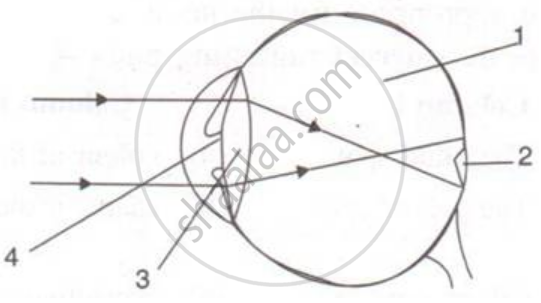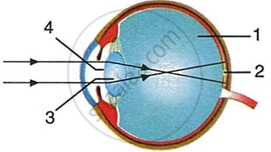Advertisements
Advertisements
प्रश्न
Observe the figure whether it is correct or not and explain the phenomenon.

उत्तर

The figure shows a myopic eye, in which the eye lens is unable to focus the light rays coming from distant objects into the retina. In this defect, the image of a distant object is formed before the retina i.e., the light rays converge before the retina. Hence, to correct the defect a diverging lens (concave lens) of proper focal length is used, so that after refraction rays reach to retina and the person can see the image clearly.
APPEARS IN
संबंधित प्रश्न
List three common refractive defects of vision. Suggest the way of correcting these defects.
What is the scientific name of
long-sightedness?
Name the defect of vision in which the eye-lens loses its power of accommodation due to old age.
What is the other name of old age hypermetropia?
Name one defect of vision (or eye) which cannot be corrected by any type of spectacle lenses.
Your friend can read a book perfectly well but cannot read the writing on blackboard unless she sits on the front row in class.
Is she short-sighted or long-sighted?
A man can read the number of a distant but clearly but he finds difficulty in reading a book.
From which defect of the eye is he suffering?
A man can read the number of a distant but clearly but he finds difficulty in reading a book.
What type of spectacle lens should he use to correct the defect?
Name the defect of vision which can be corrected by a converging lens. Show clearly by a ray diagram how the lens corrects the defect.
Name the defect of vision which can be corrected by a diverging lens. Show clearly by a ray diagram how the lens corrects the defect.
An eye has a near point distance of 0.75 m. What sort of lens in spectacles would be needed to reduce the near point distance to 0.25 m? Also calculate the power of lens required. Is this eye long-sighted or short-sighted?
An eye has a far point of 2 m. What type of lens in spectacles would be needed to increase the far point to infinity? Also calculate the power of lens required. Is this eye long-sighted or short-sighted?
The picture given here shows a person wearing 'half-moon' spectacles. What sort of eye-defect do do you think he has? Why are these particular spectacles useful to him?
Differentiate between members of the following pair with reference to what is asked in bracket.
Myopia and hyperopia (cause of the defect)
A person is unable to see distinctly the objects closer than 1 m. Name the defect of vision he is suffering from. Draw ray diagrams to illustrate the cause of the defect and its correction by suitable lens.
An old man cannot see objects closer than 1 m from the eye clearly. Name the defect of vision he is suffering from. How can it be corrected? Draw ray diagram for the (i) defect of vision and also (ii) for its correction.
Draw a ray diagram to show how Hypermetropia is defect can be corrected using a lens.
List two causes of presbyopia. Draw labelled diagram of a lens used for the correction of this defect of vision.
Choose the correct answer :
Presbyopia is a disease of _____________
Given below is a diagram depicting a defect of the human eye? Study the same and answer the question that follow:

Give two possible reasons for this defect of the eye in human beings.
Have a look at the posture of this woman who is reading a book and answer the questions which follow:

What kind of looking glasses she needs?
Rewrite the following table so as to match second and third column with first column.
|
Column I
|
Column II
|
Column III
|
|
(i) Myopia
|
Old age problem
|
Bifocal lens
|
|
(ii) Presbyopia
|
Nearsightedness
|
Concave lens.
|
The near point of the eye of a person is 50 cm. Find the nature and power of the corrective lens required by the person to enable him to see clearly the objects placed at 25 cm from the eye?
Explain the Term: Presbyopia
Explain the Term: Cataract
With respect to human eye explain:
(i) How is the image formed on the retina?
(ii) How is the amount of light entering the eye-controlled?
(iii) What type of lens is used for the correction of ‘Long sight’ defect?
(iv) With the help of a ray, diagram show the defect of the eye and then its correction after the use of a lens.
In Myopia the human eye _______.
Nearsightedness : concave lens : : farsightedness : _______
Myopia and hypermetropia can be corrected by:
Myopia may arise due to ____________.
Draw ray diagram showing myopic eye.
Correlate the given sequence:
Hypermetropia : Convex lens : ______ : Concave lens
A teacher drew the diagram of the heart on the blackboard and told the students to copy it in their notebooks. Mahesh couldn't see the diagram clearly as it appeared blurred to him.
- Name the defect of the eye Mahesh is suffering from.
- Where is the image formed in this defect?
- Mahesh consults an eye doctor and is prescribed suitable lenses to correct the defect. Which type of lens do his spectacles have?
Name the following:
Two kinds of accomodations.
Given alongside is a diagram depicting a defect of the human eye. Study the same and answer the questions that follow:
 |
- Name the defect shown in the diagram.
- Give two possible reasons for this defect.
- Name the parts labelled 1 to 4.
- Name the type of lens used to correct this eye defect.
- Draw a labelled diagram to show how the above mentioned defect is rectified using the lens named above.
